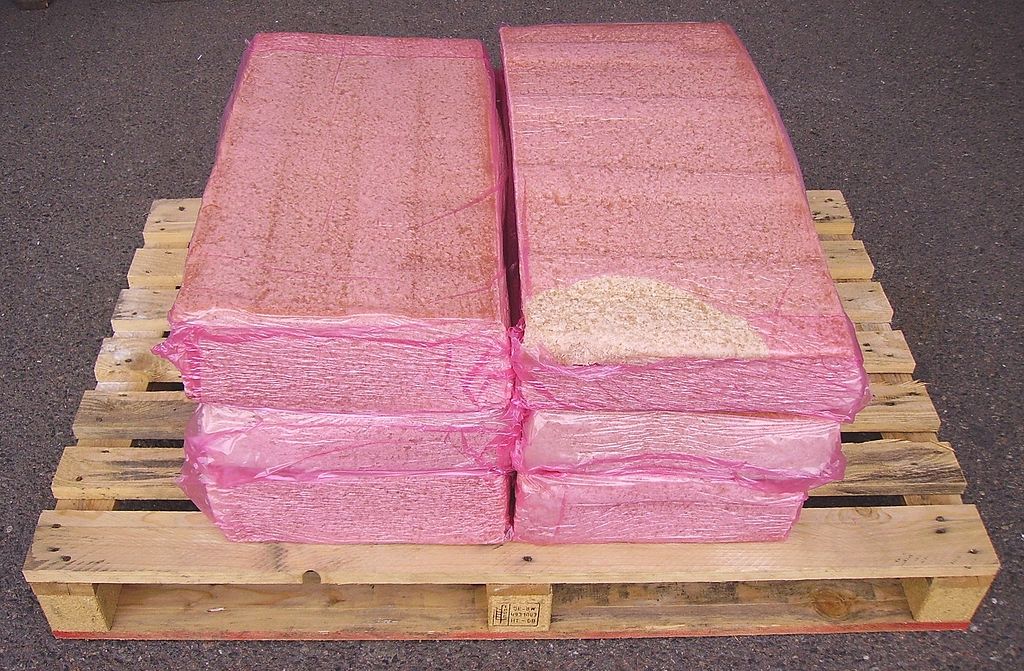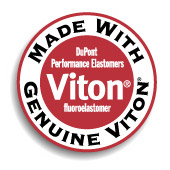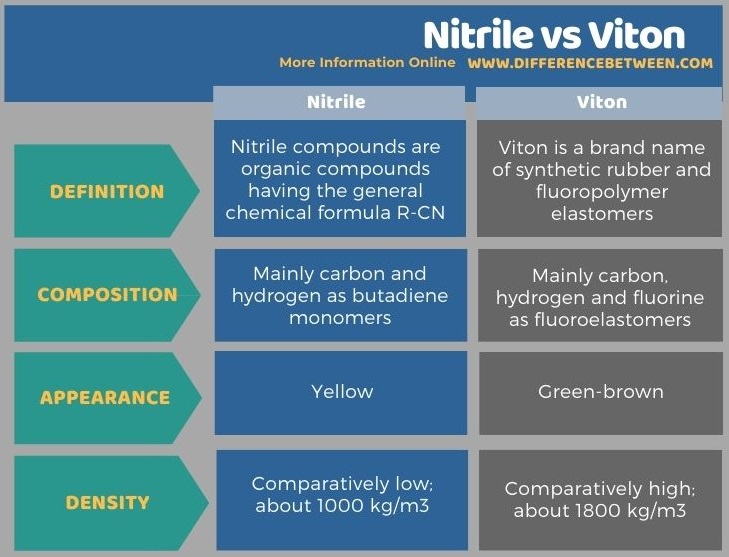Difference Between Nitrile and Viton
The key difference between nitrile and Viton is that nitrile rubber compounds have a comparatively low density while Viton has a comparatively large density.
The density measurement is a better way to distinguish nitrile rubber from Viton rubber material because the density of nitrile rubber is usually around 1000 kg/m3 while the density of Viton is about 1800 kg/m3. However, at first sight, we can identify Viton by its characteristic green-brown colour and nitrile rubber by its yellow colour.
CONTENTS
1. Overview and Key Difference
2. What is Nitrile
3. What is Viton
4. Side by Side Comparison – Nitrile vs Viton in Tabular Form
5. Summary
What is Nitrile?
Nitrile compounds are organic compounds having the general chemical formula R-CN. In other words, these compounds have a cyano group. Usually, the term cyano- is usually used interchangeably with the term nitrile in industrial applications. We can observe many important applications of nitrile compounds, including the formation of methyl cyanoacrylate, production of superglue, nitrile rubber, nitrile-containing polymers that are useful in the production of medical gloves, etc. There are many other applications of nitrile rubber as well; especially as automotive and other seals due to its resistance towards fuel and oil. More importantly, inorganic compounds containing the cyano group are not called nitrile compounds; they are called cyanides instead.

Figure 01: Nitrile Rubber Packs
When considering the structure, nitriles are linear molecules. These molecules reflect the sp hybridization of the carbon atom having the triple bond with the nitrogen atom. Nitrile compounds are polar and have a dipole moment. Nitrile compounds occur as liquids which have high relative permittivities.
We can produce a nitrile compound industrially via ammoxidation and hydrocyanation. Both these routes are sustainable (green) and have a minimum release of hazardous substances.
What is Viton?
Viton is a brand name of synthetic rubber and fluoropolymer elastomers. The name Viton is given for FKM compounds (fluorocarbon compounds). These polymer materials are useful in seals, chemical resistant gloves, and other moulded or extruded goods. The brand name “Viton” is a registered trademark of Chemours Company since 1957.

We can categorize Viton fluoroelastomers under the designation of FKM, and this category of elastomers include copolymers of hexafluoropropylene (HFP), vinylidene fluoride (VDF) and perfluoromethylvinylether (PMVE). We can observe that the fluorine content of these Viton polymers ranges from 66-70%. We can often distinguish this material from most other polymer materials due to its green-brown colour. However, a more reliable test is to identify the density of the material, which is often over 1800 Kg/m3. This density is significantly higher than most other rubber materials.
What is the Difference Between Nitrile and Viton?
Nitrile rubber and Viton are two elastomer polymer types that are different in their appearance and density. Nitrile compounds are organic compounds having the general chemical formula R-CN while Viton is a brand name of synthetic rubber and fluoropolymer elastomers. Measuring the density is a better way of distinguishing the two polymer materials. The key difference between nitrile and Viton is that nitrile rubber compounds have a comparatively low density while Viton has a comparatively a large density.
Below infographic lists more differences between nitrile and Viton.

Summary – Nitrile vs Viton
The key difference between nitrile and Viton is that nitrile rubber compounds have comparatively a low density while Viton has comparatively a large density. However, by looking at the material, we can identify Viton by its appearance of green-brown colour where nitrile rubber has a yellow colour.
Reference:
1. Timco Rubber. (n.d.). Retrieved October 22, 2020, Available here.
2. 4 Common Misconceptions About Viton or FKM Rubber. (2018, July 27). Retrieved October 22, 2020, Available here.
Image Courtesy:
1. “NBR balles” By Cjp24 – Own work (CC BY-SA 3.0) via Commons Wikimedia
2. “Genuineviton” By Source (Fair use) via Commons Wikimedia
ncG1vNJzZmivp6x7pbXFn5yrnZ6YsqOx07CcnqZemLyue8OinZ%2Bdopq7pLGMm5ytr5Wau266yK2poqSVYq6vsIyvoK2nnmQ%3D